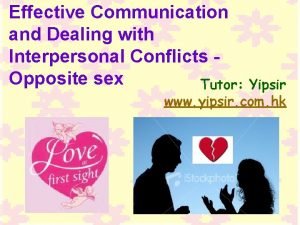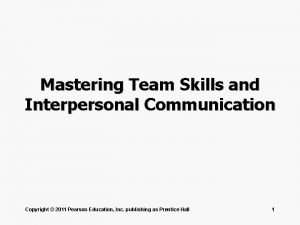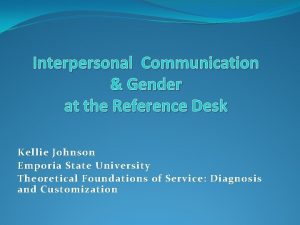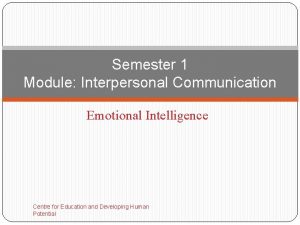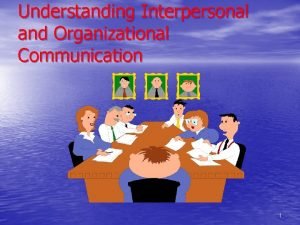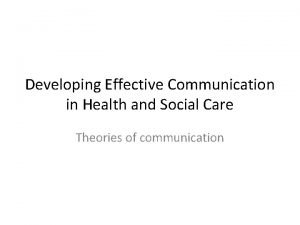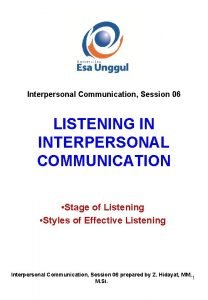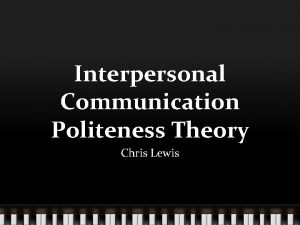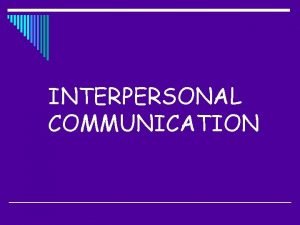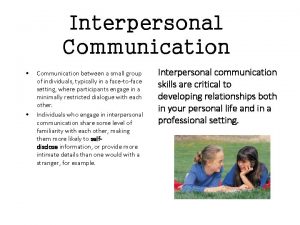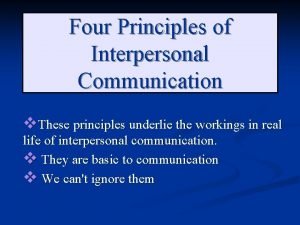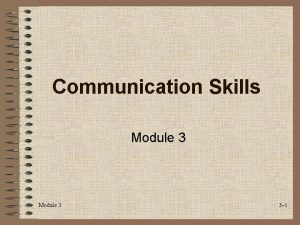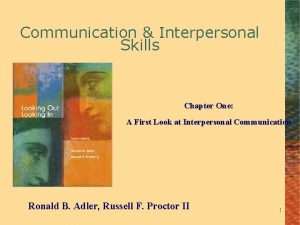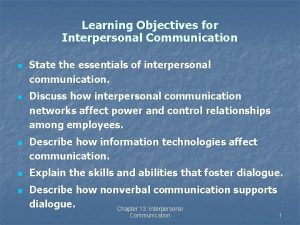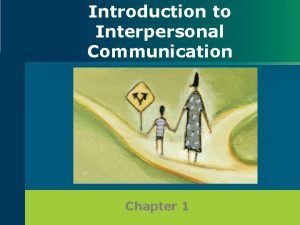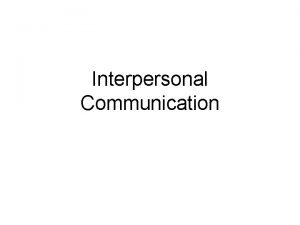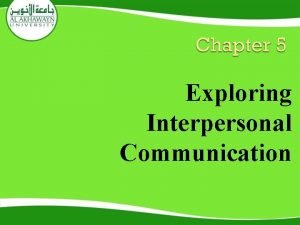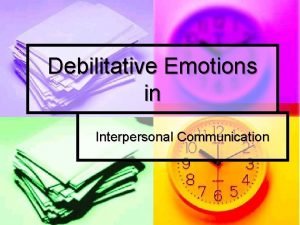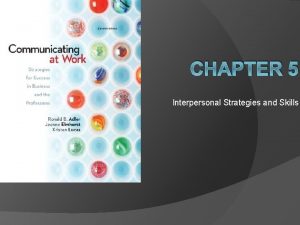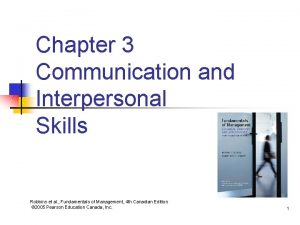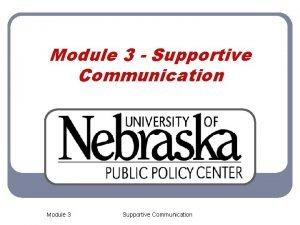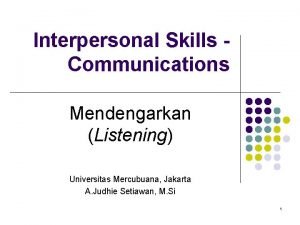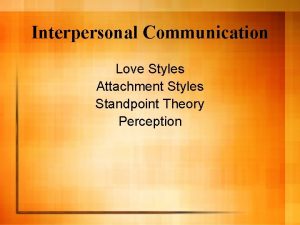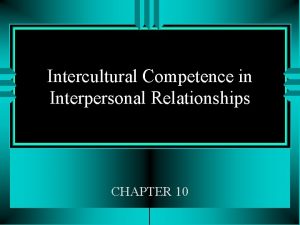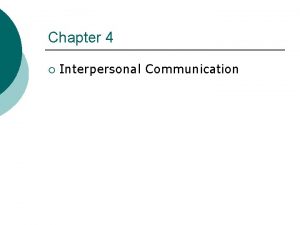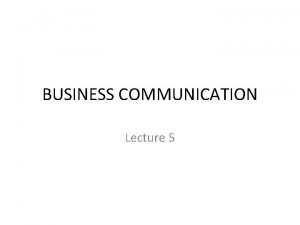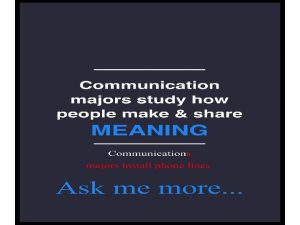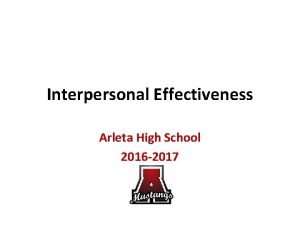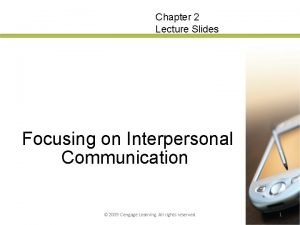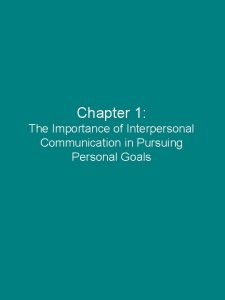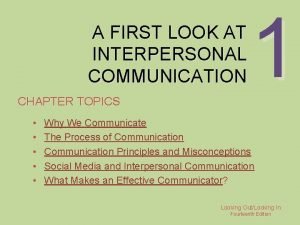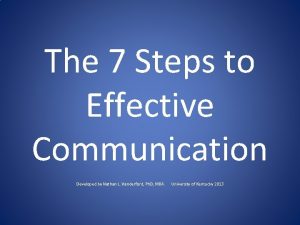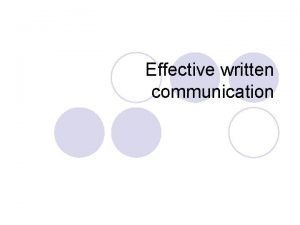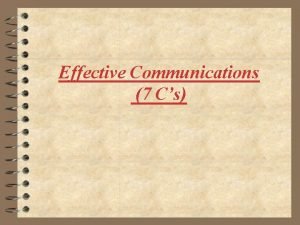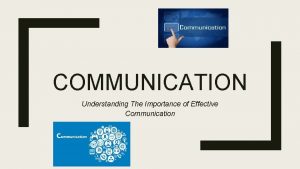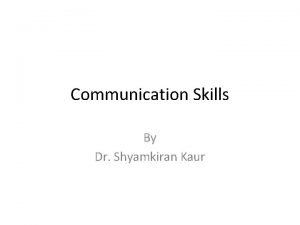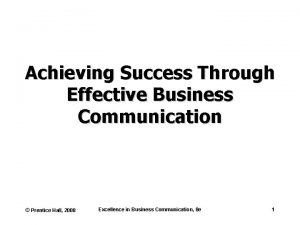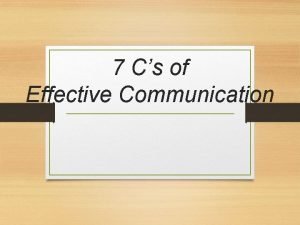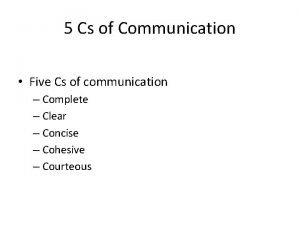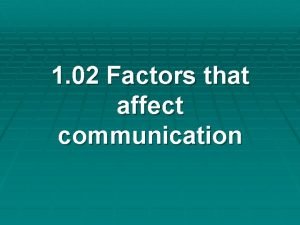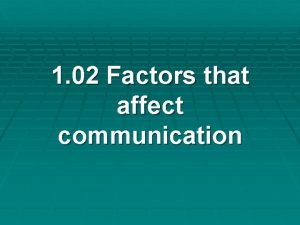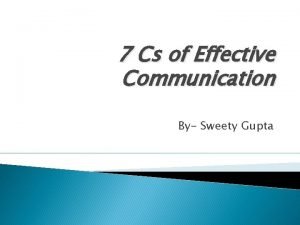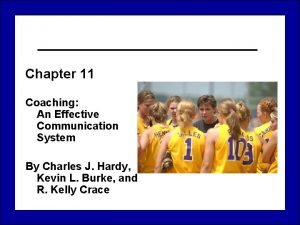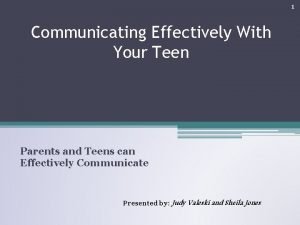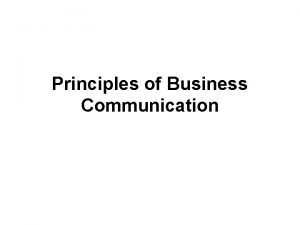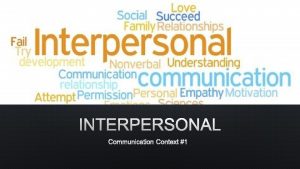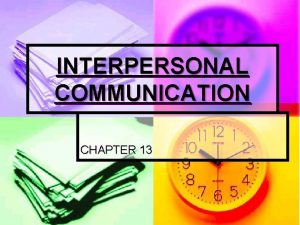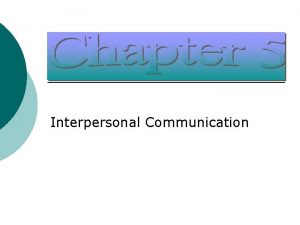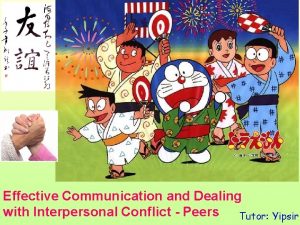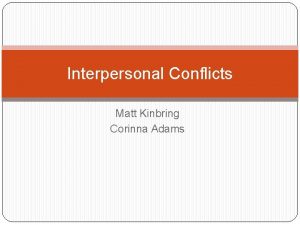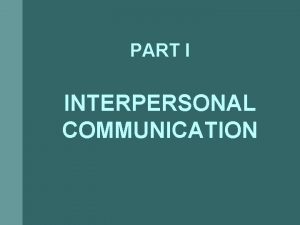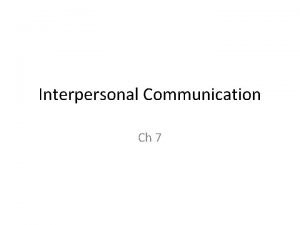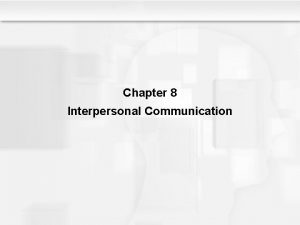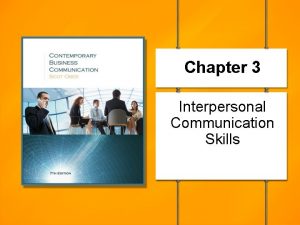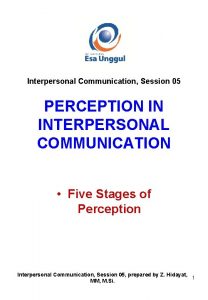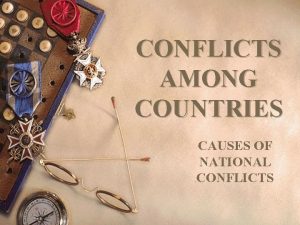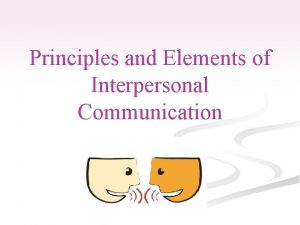Effective Communication and Dealing with Interpersonal Conflicts Opposite











































































- Slides: 75

Effective Communication and Dealing with Interpersonal Conflicts Opposite sex Tutor: Yipsir www. yipsir. com. hk

WRITTEN ASSIGNMENTS Reflection Report (40%) 1. Writing a review to explore your own development with reference to theme taught in the classes. 2. A zero mark will be given to late submission if no convincing explanation is given. 3. Plagiarism will be penalised and may affect the award of the Pre-Associate Degree.

Criteria for assessment of assignment 1. The comprehensiveness and accuracy of the content 2. The appropriate application of knowledge 3. Clarity in presentation

1. around 800 words. 2. MUST be written in English. 3. Date of submission: 27 April 2007 (Friday), week 13. 4. No marks will be given to late submission. A spare copy of the paper should be kept by the student as a back up against any loss or damage to the original one.

Sample of A, B, C and F grades papers

Participation and round up (Case presentation) (30%) 1. 2. 3. 4. Punctuality and regular attendance Participate actively in all activities and discussions and prepare themselves well by reading the prescribed readings. to share opinions or argue their points and make the discussions an interesting and fruitful learning experience. In week 14 and 15, students will form groups of three. The presentation can be made in English or Cantonese. Each group has to select and decide a real case presentation and hand it to the responsible tutor before week 14.

Contents Close Relationships and Interpersonal Attraction 2. Conflict 1.

Activity 1 Your value on love



The following are for your reference: A: love relationship, B: sexual relationship, Fisherman: money, career and materialistic life, C: conventional moral standard and social norms, and D: family life and responsibility

Close Relationships and Interpersonal Attraction

Activity 2 Are you falling in love with someone?


Love is not to find the right person ; but to be the right one.

What Defines a Close Relationship? 1. Different types q friends q parents q children q siblings q romantic partners q married couples

What Defines a Close Relationship? 1. Different types q friends q parents q children q siblings q romantic partners q married couples

What Defines a Close Relationship? 2. Behavioral interdependence q the actions of two people have mutual impact on each other

What Defines a Close Relationship? 3. Need fulfillment q the relationship must meet some basic needs n n n emotional intimacy social integration (need for affiliation) assistance to be nurturing reassurance of our self-worth

What Defines a Close Relationship? 4. Emotional attachment q must be mutual feelings of love, affection, and/or admiration

What Defines a Close Relationship? 5. Dimensions of variance q intensity q commitment q emotion q sexuality q gender

How Do People Become Attracted? 1. Exposure q the more exposure we have to a stimulus, the more positively we evaluate it q mere exposure effect n repeated exposure to a stimulus produces familiarity, and familiarity breeds liking and attraction

How Do People Become Attracted? 2. Proximity q simple physical proximity can lead to liking q proximity was best predictor of friendship q if interactions are negative, then proximity will breed disliking

How Do People Become Attracted? 3. Attitude similarity q more attracted to people who hold similar attitudes to our own than dissimilar others q We like friends of our friends and our enemy’s enemy.

How Do People Become Attracted? 4. Physical attractiveness q a simple aesthetic appeal q in an experiment, students’ rated partner’s physical attractiveness and desire to see their date again q only physical attractiveness predicted the desire to date again (intelligence, sincerity, sensitivity) q men are more willing to admit it is important (Hatfield et al. , 1966)

How Do People Become Attracted? 4. Physical attractiveness Is beauty in the “eye of the beholder”? q matching hypothesis n people tend to chose partners who are similar to them in physical attractiveness (i. e. , a “good match”) n same-sex friendships, dating couples, cohabitants, married couples n people who don’t match on physical attractiveness may be trading other

How Do People Become Attracted? 5. Reciprocity p p People like positive feedback (Coleman, Jussim, & Abraham, 1987). Even obvious attempts at flattery increase liking (Drachman et. al. 1978).

How Do People Become Attracted? 6. Conditioning q q q Association with positive or negative stimulus influences attractiveness ratings. Negative mood leads to lower attractiveness ratings (Byrne & Clore, 1970). Unpleasant background music when meeting a person leads to subsequent lower attractiveness ratings (May & Hamilton, 1980)


Types of Love 1. Companionate love (友伴的愛) q feelings of mutual respect and trust q less emotionally volatile 易發作的, 易變 的 q often found in good friendships

Types of Love 2. Passionate love (激情的愛) q intense longing for the person q physiological arousal q much more emotionally volatile

Types of Love 1. Sternberg’s Tripartite Theory of Love q passion 激情: motivational component q intimacy 親密: emotional component q commitment 承諾: cognitive component

Sternberg’s Tripartite Theory of Love intimacy 親密 passion 激情 commitment 承諾 Non-love 無愛

Sternberg’s Tripartite Theory of Love intimacy 親密 passion 激情 commitment 承諾 liking 喜歡

Sternberg’s Tripartite Theory of Love intimacy 親密 passion 激情 commitment 承諾 Infatuation 迷戀

Sternberg’s Tripartite Theory of Love intimacy 親密 passion 激情 Empty love commitment 承諾 空洞的愛

Sternberg’s Tripartite Theory of Love intimacy 親密 passion 激情 commitment 承諾 Romantic love 浪漫的愛

Sternberg’s Tripartite Theory of Love intimacy 親密 passion 激情 commitment 承諾 Companionate love 友伴的愛

Sternberg’s Tripartite Theory of Love intimacy 親密 passion 激情 Fatuous love commitment 承諾 迷糊的愛

Sternberg’s Tripartite Theory of Love intimacy 親密 passion 激情 commitment 承諾 Consummate love 圓滿的愛


Progressing from casual dating to steady dating

As a couple moves through casual to steady dating there are various changes in the nature of the relationship. These include:

1. Spending more time in each other’s company

2. An increase in positive feelings towards each other; there is more liking, loving and trust 3. An increase in the expression of feelings, * both positive and negative; * potential for the growth of both intimacy and conflict.

4. Mutual disclosure of more intimate aspects of the self, * including attitudes and values about the other partner * relationship commitment.

5. An increased concern with the other’s welfare * joy is caused by their joy, * pain by their pain. 6. Sense of unity and commitment; * both partners increasingly view themselves as a unit, * Associated with this sense of shared identity, * reduce in uncertainty about the future of the relationship.

Long Term Relationship

Long Term Relationships 1. Stage theory (SVR) q stimulus: physical attractiveness q value: similarity of values and beliefs q role: fulfillment of roles and commitment

Long Term Relationships 2. investment model of relationships q investments -- things expended on the relationships that cannot be recouped q the more investment, the more stable

Long Term Relationships 2. investment model of relationships Rewards Costs Satisfaction CL Investments CLalt Stability Commitment to the Willingness to relationship accommodate Willingness to sacrifice (adapted from Rusbult, 1983)

Long Term Relationships 2. investment model of relationships q investments were as important as satisfaction in predicting relationship commitment

Successful Relationships Unsuccessful Relationships

Successful Relationships Items on which happy couples were more similar: 1) Avoiding arguments (‘yes dear’) 2) Contributing to charity 3) Reaction to illness 4) Being alone vs. being with friends during stressful times.

Successful Relationships Attitudes about others on which happy couples were more similar: 1) Energetic People 2) Conservatives and Liberals 3) Life Insurance

Successful Relationships Over the long haul, things that happier marriages tend to have: 1) The woman maintains passionate love (Alexander & Higgins, 1993). 2) More joint activities and projects 3) Laughing together 4) Satisfaction with children (if there are kids)

Unsuccessful Relationships Over the long haul, things that lead to divorce: 1) Infidelity/Jealousy 2) Failure to compromise 3) Failure to express emotions/communicate 4) Dissimilarity emerging over time (or being discovered over time). 5 ) Sexual dissatisfaction

Conclusion Many types of close relationships that vary along many dimensions 2. Interpersonal attraction is multifaceted, but physical attractiveness plays an important role 3. Love can vary in type and among different relationships 4. Relationship satisfaction and investment are critical to relationships stability 1.

Conflicts Management in Opposite Sex Relationship

Film 12 nights

Functions of conflict 1. Reflects the different views and feelings of the couple. 2. If conflict could be coped, it promoted better mutual understanding. 3. If not, it paves future conflict in the relationship.

Conflict in dating Functions of conflict: Learn how to handle conflict (prepare for later conflict in marriage) 2. Promote better understanding 1. Hence, learning how to manage conflict in dating is absolutely important in premarital preparation.

Conflict management in dating A. The need to understand the differences between men and women in: - expectation towards being loved - expressing needs - emotions

Sexual differences towards conflict Male Female p Please the lover so as q Wants to be to win the loving pleased by the relationship. lover to make her (Achievement-oriented) feeling important. After marriage, will not q Wants solution at please her anymore. once. q Pushes for an p Needs ‘space’ to take a answer. break, to settle and to think of solution.

Sexual differences towards conflict Male q Not expressive on emotions and needs. q q Not sensitive enough to aware of his emotions and needs Not initiative enough to face conflict Female q More expressive on emotions and needs. q q More sensitive to aware of her emotions and needs More aggressive to push for an answer or solution.

Compromises in conflict 1. Fair compromises : - each of them gives in 1. Unfair compromise q Only one party gives in (It hurts one’s self-worth and self-image) (It builds an unhealthy relationship)

5 Major Components of Love 1. 2. 3. 4. 5. Care Responsibility Respect Knowledge Commitment






Handling break-up of love 1. Need to bring out the discomfort and differences, discontentment etc 2. Talk about the above differences to see if they can be solved or not 3. Need to tell the partner the reasons for breaking-up. (Breaking-up suddenly without good reasons hurts the dignity and self-esteem of the partner. )

Handling break-up of love 1. To break up in an assertive manner so as not to create confusion or unclear message. 2. Don’t be afraid of facing the hurtful feelings of the partner. Tell him or her directly. 3. Both of you need time to adjust after the breaking-up.

 Interpersonal communication chapter 6
Interpersonal communication chapter 6 Examples of mass communication
Examples of mass communication Interpersonal skills opposite
Interpersonal skills opposite Intra and interpersonal skills
Intra and interpersonal skills Mastering team skills and interpersonal communication
Mastering team skills and interpersonal communication Communication and interpersonal skills
Communication and interpersonal skills Gender interpersonal communication
Gender interpersonal communication Interpersonal communication and emotional intelligence
Interpersonal communication and emotional intelligence Skills job application
Skills job application Attitude barriers to communication
Attitude barriers to communication Interpersonal and organizational communication
Interpersonal and organizational communication Interpersonal skills in social care
Interpersonal skills in social care Self concept and interpersonal communication
Self concept and interpersonal communication Communication groups
Communication groups Communication english skills
Communication english skills Listening in interpersonal communication
Listening in interpersonal communication Preventative facework
Preventative facework What is communication is contextual
What is communication is contextual Interpersonal communication examples
Interpersonal communication examples Chapter 6 interpersonal communication
Chapter 6 interpersonal communication Interpersonal communication is irreversible
Interpersonal communication is irreversible Module 3 communication/interpersonal skills
Module 3 communication/interpersonal skills Qualitative interpersonal communication
Qualitative interpersonal communication Masspersonal communication
Masspersonal communication Wheel network
Wheel network Interpersonal communication ethics
Interpersonal communication ethics Barriers to interpersonal skills
Barriers to interpersonal skills Exploring interpersonal communication
Exploring interpersonal communication Facilitative and debilitative emotion examples
Facilitative and debilitative emotion examples Chapter 5 interpersonal communication
Chapter 5 interpersonal communication Chapter 3 communication skills
Chapter 3 communication skills Supportive
Supportive Interpersonal skills in business communication
Interpersonal skills in business communication Interpersonal skills listening
Interpersonal skills listening Standpoint theory interpersonal communication
Standpoint theory interpersonal communication Interpersonal communication competence requires
Interpersonal communication competence requires Noise in communication
Noise in communication Strategies for successful interpersonal communication
Strategies for successful interpersonal communication Axioms of interpersonal communication
Axioms of interpersonal communication Interpersonal relationship
Interpersonal relationship Example of interpersonal communication
Example of interpersonal communication Chapter 8 interpersonal communication
Chapter 8 interpersonal communication Interpersonal communication chapter 2
Interpersonal communication chapter 2 Instrumental goals interpersonal communication
Instrumental goals interpersonal communication Universal of interpersonal communication
Universal of interpersonal communication A first look at interpersonal communication
A first look at interpersonal communication Chapter 5 lesson 1 dealing with anxiety and depression
Chapter 5 lesson 1 dealing with anxiety and depression Chapter 5 lesson 1 dealing with anxiety and depression
Chapter 5 lesson 1 dealing with anxiety and depression Chapter 9 resolving conflicts and preventing violence
Chapter 9 resolving conflicts and preventing violence Chapter 9 resolving conflicts and preventing violence
Chapter 9 resolving conflicts and preventing violence The old man and the sea criticism
The old man and the sea criticism Character conflicts in the crucible
Character conflicts in the crucible Effective written communication
Effective written communication 7 steps of effective communication
7 steps of effective communication The 5 inevitable laws of effective communication
The 5 inevitable laws of effective communication Factor affecting of communication
Factor affecting of communication Effective written communication
Effective written communication What is the importance of 7 c's of effective communication
What is the importance of 7 c's of effective communication Jerry macnamara
Jerry macnamara Importance of communication
Importance of communication Effectively communicate meaning
Effectively communicate meaning Ethics of communication
Ethics of communication Objective of listening
Objective of listening Competing messages communication barriers
Competing messages communication barriers Conveying the message in the least possible words
Conveying the message in the least possible words What are the 5cs of communication
What are the 5cs of communication Factors that affect communication
Factors that affect communication Factors that affect communication
Factors that affect communication Effective communication types
Effective communication types How to write a bluf
How to write a bluf 7 c's of effective communication
7 c's of effective communication Coaching in effective communication
Coaching in effective communication Advantages of verbal communication
Advantages of verbal communication Effective communication with your teenager
Effective communication with your teenager What are the principles of business communication
What are the principles of business communication Objectives of verbal communication
Objectives of verbal communication


